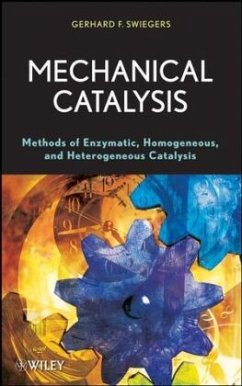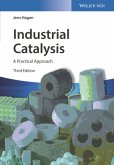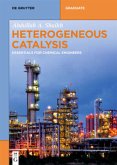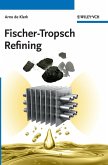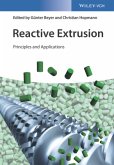- Gebundenes Buch
- Merkliste
- Auf die Merkliste
- Bewerten Bewerten
- Teilen
- Produkt teilen
- Produkterinnerung
- Produkterinnerung
The authoritative reference on time-dependent (mechanical) catalysis, as employed by many enzymes and sought in their man-made mimics
This book examines the principles of mechanics as they apply to chemistry and, more particularly, catalysis. It's a unique, comprehensive resource focusing on unconventional time-dependent (mechanical) catalysis, instead of the more familiar energy-dependent (thermodynamic) catalysis. To help practitioners envision how catalyst-reactant dynamism leads to time-dependent catalysis, it: _ Demonstrates the existence of two fundamentally different forms of…mehr
Andere Kunden interessierten sich auch für
![Recoverable and Recyclable Catalysts Recoverable and Recyclable Catalysts]() Recoverable and Recyclable Catalysts165,99 €
Recoverable and Recyclable Catalysts165,99 €![Industrial Catalysis Industrial Catalysis]() Jens HagenIndustrial Catalysis152,99 €
Jens HagenIndustrial Catalysis152,99 €![Heterogeneous Catalysis Heterogeneous Catalysis]() Abdullah A. ShaikhHeterogeneous Catalysis54,99 €
Abdullah A. ShaikhHeterogeneous Catalysis54,99 €![Fischer-Tropsch Refining Fischer-Tropsch Refining]() Arno de KlerkFischer-Tropsch Refining162,99 €
Arno de KlerkFischer-Tropsch Refining162,99 €![Reactive Extrusion Reactive Extrusion]() Reactive Extrusion109,99 €
Reactive Extrusion109,99 €![Engineering Catalysis Engineering Catalysis]() Dmitry Yu. MurzinEngineering Catalysis74,99 €
Dmitry Yu. MurzinEngineering Catalysis74,99 €![Kinetics of Catalytic Reactions Kinetics of Catalytic Reactions]() M. Albert VanniceKinetics of Catalytic Reactions49,99 €
M. Albert VanniceKinetics of Catalytic Reactions49,99 €-
-
-
The authoritative reference on time-dependent (mechanical) catalysis, as employed by many enzymes and sought in their man-made mimics
This book examines the principles of mechanics as they apply to chemistry and, more particularly, catalysis. It's a unique, comprehensive resource focusing on unconventional time-dependent (mechanical) catalysis, instead of the more familiar energy-dependent (thermodynamic) catalysis. To help practitioners envision how catalyst-reactant dynamism leads to time-dependent catalysis, it:
_ Demonstrates the existence of two fundamentally different forms of "reaction-limited" catalysis, namely time-dependent (mechanical) and energy-dependent (thermodynamic) catalysis
_ Describes their physical manifestation in heterogeneous and homogeneous systems
_ Shows how many enzymes use time-dependent catalytic reactions
_ Unravels the mystery of enzymatic catalysis, including: the fundamental processes at work, the origin of its general and physical features, the way it has evolved, and how it relates to catalysis in man-made systems
_ Unifies homogeneous, heterogeneous, and enzymatic catalysis, and explains how the thirty or so general theories of enzymatic catalysis are knit together into a conceptually coherent whole
_ Describes how to authentically mimic the underlying principles of enzymatic catalysis in man-made systems, including: the design requirements for such catalysts, the difficulties in duplicating the natural process, and the approaches that may be used to overcome these challenges
_ Describes the role of catalysis in the emerging field of complex systems science
A key resource for chemists, biochemists, and chemical engineers, this is also a reference for students of complex systems science and researchers in a variety of fields, including economics, evolution, weather forecasting, traffic management, and networking.
Hinweis: Dieser Artikel kann nur an eine deutsche Lieferadresse ausgeliefert werden.
This book examines the principles of mechanics as they apply to chemistry and, more particularly, catalysis. It's a unique, comprehensive resource focusing on unconventional time-dependent (mechanical) catalysis, instead of the more familiar energy-dependent (thermodynamic) catalysis. To help practitioners envision how catalyst-reactant dynamism leads to time-dependent catalysis, it:
_ Demonstrates the existence of two fundamentally different forms of "reaction-limited" catalysis, namely time-dependent (mechanical) and energy-dependent (thermodynamic) catalysis
_ Describes their physical manifestation in heterogeneous and homogeneous systems
_ Shows how many enzymes use time-dependent catalytic reactions
_ Unravels the mystery of enzymatic catalysis, including: the fundamental processes at work, the origin of its general and physical features, the way it has evolved, and how it relates to catalysis in man-made systems
_ Unifies homogeneous, heterogeneous, and enzymatic catalysis, and explains how the thirty or so general theories of enzymatic catalysis are knit together into a conceptually coherent whole
_ Describes how to authentically mimic the underlying principles of enzymatic catalysis in man-made systems, including: the design requirements for such catalysts, the difficulties in duplicating the natural process, and the approaches that may be used to overcome these challenges
_ Describes the role of catalysis in the emerging field of complex systems science
A key resource for chemists, biochemists, and chemical engineers, this is also a reference for students of complex systems science and researchers in a variety of fields, including economics, evolution, weather forecasting, traffic management, and networking.
Hinweis: Dieser Artikel kann nur an eine deutsche Lieferadresse ausgeliefert werden.
Produktdetails
- Produktdetails
- Verlag: Wiley & Sons
- 1. Auflage
- Seitenzahl: 384
- Erscheinungstermin: 1. September 2008
- Englisch
- Abmessung: 241mm x 159mm x 25mm
- Gewicht: 660g
- ISBN-13: 9780470262023
- ISBN-10: 0470262028
- Artikelnr.: 25065822
- Herstellerkennzeichnung
- Libri GmbH
- Europaallee 1
- 36244 Bad Hersfeld
- gpsr@libri.de
- Verlag: Wiley & Sons
- 1. Auflage
- Seitenzahl: 384
- Erscheinungstermin: 1. September 2008
- Englisch
- Abmessung: 241mm x 159mm x 25mm
- Gewicht: 660g
- ISBN-13: 9780470262023
- ISBN-10: 0470262028
- Artikelnr.: 25065822
- Herstellerkennzeichnung
- Libri GmbH
- Europaallee 1
- 36244 Bad Hersfeld
- gpsr@libri.de
Gerhard F. Swiegers, PhD, earned his doctorate at the University of Connecticut in 1991 and then worked at the Australian National University and the University of Wollongong, Australia. In 1998, he joined the Commonwealth Scientific and Industrial Research Organization (CSIRO), the major government laboratory in Australia. From 1998 to 2006, he was involved with designing anti-counterfeiting devices for bank notes. In 2005, one of his inventions was commercialized as a spin-off company known as Datatrace DNA Pty Ltd, and in 2006, Dr. Swiegers joined the firm as Vice President, Strategic Research. Several of Dr. Swiegers's inventions are currently used by national governments and major companies around the world.
PREFACE.
CONTRIBUTORS.
GLOSSARY.
1. Introduction to Thermodynamic (Energy-Dependent) and Mechanical
(Time-Dependent) Processes: What Are They and How Are They Manifested in
Chemistry and Catalysis? (Gerhard F. Swiegers).
1.1 Thermodynamic (Energy-Dependent) and Mechanical (Time-Dependent)
Processes.
1.2 What Is a Thermodynamic Process?
1.3 What Is a Mechanical Process?
1.4 The Difference between Energy-Dependent (Thermodynamic) and
Time-Dependent (Mechanical) Processes.
1.5 Time- and Energy-Dependence in Chemistry and Catalysis.
1.6 The Aims, Structure, and Major Findings of this Series.
2. Heterogeneous, Homogeneous, and Enzymatic Catalysis. A Shared
Terminology and Conceptual Platform. The Alternative of Time-Dependence in
Catalysis (Gerhard F. Swiegers).
2.1 Introduction: The Problem of Conceptually Unifying Heterogeneous,
Homogeneous, and Enzymatic Catalysis? Trends in Catalysis Science.
2.2 Background: What Is Heterogeneous, Homogeneous, and Enzymatic
Catalysis.
2.3 Distinctions Within Homogeneous Catalysis: Single-Centered and
Multicentered Homogeneous Catalysis.
2.4 The Distinction between Single-Site/Multisite Catalysts and
Single-Centered/MultiCentered Catalysts in Heterogeneous Catalysis: An
Important Convention Used in This Series.
2.5 The Alternative of Time-Dependence in Catalysis.
3. A Conceptual Description of Energy-Dependent ("Thermodynamic") and
Time-Dependent ("Mechanical") Processes in Chemistry and Catalysis
(Gerhard F. Swiegers).
3.1 Introduction.
3.2 Theoretical Considerations: Common Processes in Uncatalyzed Reactions.
3.3 Theoretical Considerations: Common Processes in Catalyzed Reactions.
4. Time-Dependence in Heterogeneous Catalysis. Sabatier's Principle
Describes Two Independent Catalytic Realms: Time-Dependent ("Mechanical")
Catalysis and Energy-Dependent ("Thermodynamic") Catalysis (Gerhard F.
Swiegers).
4.1 Introduction.
4.2 Sabatier's Principle in Heterogeneous Catalysis.
4.3 Exceptions to Sabatier's Principle.
4.4 Sabatier's Principle in Homogeneous Catalysis.
4.5 Conclusions. Sabatier's Principle Describes Two Independent Catalytic
Domains: Energy- and Time-Dependent Catalysis.
5. Time-Dependence in Homogeneous Catalysis. 1. Many Enzymes Display the
Hallmarks of Time-Dependent ("Mechanical") Catalysis. Nonbiological
Homogeneous Catalysts Are Typically Energy-Dependent ("Thermodynamic")
Catalysts (Robin Brimblecombe, Jun Chen, Junhua Huang, Ulrich T.
Mueller-Westerhoff and Gerhard F. Swiegers).
5.1 Introduction.
5.2 Historical Background: Are Enzymes Generally Energy-Dependent or
Time-Dependent Catalysts?
5.3 The Methodology of This Chapter: Identify, Contrast, and Rationalize
the Common Processes Present in Biological and Nonbiological Homogeneous
Catalysts.
5.4 Does Michaelis-Menten Kinetics in Enzymes Indicate that They Are
Time-Dependent Catalysts?
5.5 Other General Characteristics of Catalysis by Enzymes and Comparable
Nonbiological Homogeneous Catalysts.
5.6 Rationalization of the Underlying Processes. The Mechanism of Action in
Time-Dependent and Energy-Dependent Catalysts.
5.7 All Generalizations Support Time-Dependence in Enzymes.
5.8 Time-Dependence in a Nonbiological Catalyst Generates the Distinctive
Properties of Enzymes.
5.9 Conclusion: Many Enzymes Are Time-Dependent Catalysts.
6. Time-Dependence in Homogeneous Catalysis. 2. The General Actions of
Time-Dependent ("Mechanical") and Energy-Dependent ("Thermodynamic")
Catalysts (Robin Brimblecombe, Jun Chen, Junhua Huang, Ulrich T.
Mueller-Westerhoff, and Gerhard F. Swiegers).
6.1 Introduction.
6.2 Time- and Energy-Dependent, Multicentered Homogeneous Catalysts.
6.3 The Action of Energy-Dependent, Multicentered Homogeneous Catalysts.
6.4 The Action of Time-Dependent, Multicentered Homogeneous Catalysts.
6.5 The Importance of Recognizing Time-Dependent Catalysis.
6.6 Time-Dependent Catalysis Is Very Different to Energy-Dependent
Catalysis and Therefore Seems Unfamiliar.
6.7 Conclusions for Biology.
6.8 Conclusions for Homogeneous Catalysis.
6.9 The "Ideal" Homogeneous Catalyst.
6.10 Conclusions for the Conceptual Unity of the Field of Catalysis.
7. Unifying the Many Theories of Enzymatic Catalysis. Theories of Enzymatic
Catalysis Fall into Two Camps: Energy-Dependent ("Thermodynamic") and
Time-Dependent ("Mechanical") Catalysis (Gerhard F. Swiegers).
7.1 Introduction.
7.2 Theories of Enzymatic Catalysis.
7.3 Theories Explaining Enzymatic Catalysis Fall into Two Camps:
Energy-Dependent and Time-Dependent Catalysis.
7.4 Studies Verifying Pauling's Theory in Model Systems Are Correct, but
Describe Energy-Dependent and not Time-Dependent Catalysis.
7.5 The Anomaly Described in the Spatiotemporal Hypothesis Originates, in
Part, from the Onset of Time-Dependence.
8. Synergy in Heterogeneous, Homogeneous, and Enzymatic Catalysis. The
"Ideal" Catalyst (Gerhard F. Swiegers).
8.1 Introduction.
8.2 Synergy in Heterogeneous Catalysts.
8.3 Single-Centered Nonbiological Homogeneous Catalysts and Their 'Mutually
Enhancing' Synergies.
8.4 Multicentered, Energy-Dependent Homogeneous Catalysts and Their
Functionally Complementary Synergies.
8.5 Enzymes and Their Functionally Convergent Synergies.
8.6 Biomimetic Chemistry and Its Pseudo-Convergent Synergies.
8.7 The Spectrum of Synergistic Action in Homogeneous Catalysis.
8.8 Synergy in Catalysis Is Conceptually Related to Other Synergistic
Processes in Human Experience.
9. A Conceptual Unification of Heterogeneous, Homogeneous, and Enzymatic
Catalysis (Gerhard F. Swiegers).
9.1 Introduction.
9.2 Diffusion-Controlled and Reaction-Controlled Catalysis.
9.3 The Diversity of Catalytic Action in Heterogeneous Catalysts.
9.4 The Diversity of Catalytic Action in Nonbiological Homogeneous
Catalysts.
9.5 The Diversity of Catalytic Action in Enzymes.
9.6 Heterogeneous Catalysis and Enzymatic Catalysis Has, Effectively,
Involved Combinatorial Experiments that Have Produced Time-Dependent
Catalysts. Nonbiological Homogeneous Catalysis Has Not.
9.7 Homogeneous and Enzymatic Catalysts Are the 3-D Equivalent of 2-D
Heterogeneous Catalysts.
9.8 A Conceptual Unification of Heterogeneous, Homogeneous, and Enzymatic
Catalysis.
10. The Rational Design of Time-Dependent ("Mechanical") Homogeneous
Catalysts. A Literature Survey of Multicentered Homogeneous Catalysis
(Junhua Huang and Gerhard F. Swiegers).
10.1 Introduction.
10.2 The Rational Design of Time-Dependent Homogeneous Catalysts.
10.3 Elements of Rational Design in Multicentered Catalysis.
10.4 A Review of Nonbiological, Multicentered Molecular Catalysts Described
in the Chemical Literature.
11. Time-Dependent ("Mechanical"), Nonbiological Catalysis. 1. A Fully
Functional Mimic of the Water-Oxidizing Center (WOC) in Photosystem II
(PSII) (Robin Brimblecombe, G. Charles Dismukes, Greg A. Felton, Leone
Spiccia, and Gerhard F. Swiegers).
11.1 Introduction.
11.2 The Physical and Chemical Properties of the Cubanes 1a-b.
11.3 Nafion Provides a Means of Solubilizing and Immobilizing Hydrophobic
Metal Complexes.
11.4 Photoelectrochemical Cells and Dye-Sensitized Solar Cells for
Water-Splitting.
11.5 Photocatalytic Water Oxidation by Cubane 1b Doped into a Nafion
Support.
11.6 The Challenge of Dye-Sensitized Water-Splitting.
11.7 The Mechanism of the Catalysis.
11.8 Conclusions.
12. Time-Dependent ("Mechanical"), Nonbiological Catalysis. 2. Highly
Efficient, "Biomimetic" Hydrogen-Generating Electrocatalysts (Jun Chen,
Junhua Huang, Gerhard F. Swiegers, Chee O. Too, and Gordon G. Wallace).
12.1 Introduction.
12.2 Monomer and Polymer Preparation.
12.3 Catalytic Experiments.
12.4 Conclusions: A Combinatorial "Statistical Proximity" Catalyst Was
Obtained as a Bulk, Hybrid Homogeneous-Heterogeneous Catalyst.
13. Time-Dependent ("Mechanical"), Nonbiological Catalysis. 3. A Readily
Prepared, Convergent, Oxygen-Reduction Electrocatalyst (Jun Chen, Gerhard
F. Swiegers, Gordon G. Wallace, and Weimin Zhang).
13.1 Introduction.
13.2 Cofacial Diporphyrin Oxygen-Reduction Catalysts.
13.3 Vapor-Phase Polymerization of Pyrrole as a Means of Immobilizing High
Concentrations of Monomeric Catalytic Groups at an Electrode Surface.
13.4 Preparation and Catalytic Properties of PPy-3.
13.5 PPy-3 as a Fuel Cell Catalyst.
13.6 Conclusions.
Appendix A Why Is Saturation Not Observed in Catalysts that Display
Conventional Kinetics?
Appendix B Graphical Illustration of the Processes Involved in the
Saturation of Molecular Catalysts.
Index.
CONTRIBUTORS.
GLOSSARY.
1. Introduction to Thermodynamic (Energy-Dependent) and Mechanical
(Time-Dependent) Processes: What Are They and How Are They Manifested in
Chemistry and Catalysis? (Gerhard F. Swiegers).
1.1 Thermodynamic (Energy-Dependent) and Mechanical (Time-Dependent)
Processes.
1.2 What Is a Thermodynamic Process?
1.3 What Is a Mechanical Process?
1.4 The Difference between Energy-Dependent (Thermodynamic) and
Time-Dependent (Mechanical) Processes.
1.5 Time- and Energy-Dependence in Chemistry and Catalysis.
1.6 The Aims, Structure, and Major Findings of this Series.
2. Heterogeneous, Homogeneous, and Enzymatic Catalysis. A Shared
Terminology and Conceptual Platform. The Alternative of Time-Dependence in
Catalysis (Gerhard F. Swiegers).
2.1 Introduction: The Problem of Conceptually Unifying Heterogeneous,
Homogeneous, and Enzymatic Catalysis? Trends in Catalysis Science.
2.2 Background: What Is Heterogeneous, Homogeneous, and Enzymatic
Catalysis.
2.3 Distinctions Within Homogeneous Catalysis: Single-Centered and
Multicentered Homogeneous Catalysis.
2.4 The Distinction between Single-Site/Multisite Catalysts and
Single-Centered/MultiCentered Catalysts in Heterogeneous Catalysis: An
Important Convention Used in This Series.
2.5 The Alternative of Time-Dependence in Catalysis.
3. A Conceptual Description of Energy-Dependent ("Thermodynamic") and
Time-Dependent ("Mechanical") Processes in Chemistry and Catalysis
(Gerhard F. Swiegers).
3.1 Introduction.
3.2 Theoretical Considerations: Common Processes in Uncatalyzed Reactions.
3.3 Theoretical Considerations: Common Processes in Catalyzed Reactions.
4. Time-Dependence in Heterogeneous Catalysis. Sabatier's Principle
Describes Two Independent Catalytic Realms: Time-Dependent ("Mechanical")
Catalysis and Energy-Dependent ("Thermodynamic") Catalysis (Gerhard F.
Swiegers).
4.1 Introduction.
4.2 Sabatier's Principle in Heterogeneous Catalysis.
4.3 Exceptions to Sabatier's Principle.
4.4 Sabatier's Principle in Homogeneous Catalysis.
4.5 Conclusions. Sabatier's Principle Describes Two Independent Catalytic
Domains: Energy- and Time-Dependent Catalysis.
5. Time-Dependence in Homogeneous Catalysis. 1. Many Enzymes Display the
Hallmarks of Time-Dependent ("Mechanical") Catalysis. Nonbiological
Homogeneous Catalysts Are Typically Energy-Dependent ("Thermodynamic")
Catalysts (Robin Brimblecombe, Jun Chen, Junhua Huang, Ulrich T.
Mueller-Westerhoff and Gerhard F. Swiegers).
5.1 Introduction.
5.2 Historical Background: Are Enzymes Generally Energy-Dependent or
Time-Dependent Catalysts?
5.3 The Methodology of This Chapter: Identify, Contrast, and Rationalize
the Common Processes Present in Biological and Nonbiological Homogeneous
Catalysts.
5.4 Does Michaelis-Menten Kinetics in Enzymes Indicate that They Are
Time-Dependent Catalysts?
5.5 Other General Characteristics of Catalysis by Enzymes and Comparable
Nonbiological Homogeneous Catalysts.
5.6 Rationalization of the Underlying Processes. The Mechanism of Action in
Time-Dependent and Energy-Dependent Catalysts.
5.7 All Generalizations Support Time-Dependence in Enzymes.
5.8 Time-Dependence in a Nonbiological Catalyst Generates the Distinctive
Properties of Enzymes.
5.9 Conclusion: Many Enzymes Are Time-Dependent Catalysts.
6. Time-Dependence in Homogeneous Catalysis. 2. The General Actions of
Time-Dependent ("Mechanical") and Energy-Dependent ("Thermodynamic")
Catalysts (Robin Brimblecombe, Jun Chen, Junhua Huang, Ulrich T.
Mueller-Westerhoff, and Gerhard F. Swiegers).
6.1 Introduction.
6.2 Time- and Energy-Dependent, Multicentered Homogeneous Catalysts.
6.3 The Action of Energy-Dependent, Multicentered Homogeneous Catalysts.
6.4 The Action of Time-Dependent, Multicentered Homogeneous Catalysts.
6.5 The Importance of Recognizing Time-Dependent Catalysis.
6.6 Time-Dependent Catalysis Is Very Different to Energy-Dependent
Catalysis and Therefore Seems Unfamiliar.
6.7 Conclusions for Biology.
6.8 Conclusions for Homogeneous Catalysis.
6.9 The "Ideal" Homogeneous Catalyst.
6.10 Conclusions for the Conceptual Unity of the Field of Catalysis.
7. Unifying the Many Theories of Enzymatic Catalysis. Theories of Enzymatic
Catalysis Fall into Two Camps: Energy-Dependent ("Thermodynamic") and
Time-Dependent ("Mechanical") Catalysis (Gerhard F. Swiegers).
7.1 Introduction.
7.2 Theories of Enzymatic Catalysis.
7.3 Theories Explaining Enzymatic Catalysis Fall into Two Camps:
Energy-Dependent and Time-Dependent Catalysis.
7.4 Studies Verifying Pauling's Theory in Model Systems Are Correct, but
Describe Energy-Dependent and not Time-Dependent Catalysis.
7.5 The Anomaly Described in the Spatiotemporal Hypothesis Originates, in
Part, from the Onset of Time-Dependence.
8. Synergy in Heterogeneous, Homogeneous, and Enzymatic Catalysis. The
"Ideal" Catalyst (Gerhard F. Swiegers).
8.1 Introduction.
8.2 Synergy in Heterogeneous Catalysts.
8.3 Single-Centered Nonbiological Homogeneous Catalysts and Their 'Mutually
Enhancing' Synergies.
8.4 Multicentered, Energy-Dependent Homogeneous Catalysts and Their
Functionally Complementary Synergies.
8.5 Enzymes and Their Functionally Convergent Synergies.
8.6 Biomimetic Chemistry and Its Pseudo-Convergent Synergies.
8.7 The Spectrum of Synergistic Action in Homogeneous Catalysis.
8.8 Synergy in Catalysis Is Conceptually Related to Other Synergistic
Processes in Human Experience.
9. A Conceptual Unification of Heterogeneous, Homogeneous, and Enzymatic
Catalysis (Gerhard F. Swiegers).
9.1 Introduction.
9.2 Diffusion-Controlled and Reaction-Controlled Catalysis.
9.3 The Diversity of Catalytic Action in Heterogeneous Catalysts.
9.4 The Diversity of Catalytic Action in Nonbiological Homogeneous
Catalysts.
9.5 The Diversity of Catalytic Action in Enzymes.
9.6 Heterogeneous Catalysis and Enzymatic Catalysis Has, Effectively,
Involved Combinatorial Experiments that Have Produced Time-Dependent
Catalysts. Nonbiological Homogeneous Catalysis Has Not.
9.7 Homogeneous and Enzymatic Catalysts Are the 3-D Equivalent of 2-D
Heterogeneous Catalysts.
9.8 A Conceptual Unification of Heterogeneous, Homogeneous, and Enzymatic
Catalysis.
10. The Rational Design of Time-Dependent ("Mechanical") Homogeneous
Catalysts. A Literature Survey of Multicentered Homogeneous Catalysis
(Junhua Huang and Gerhard F. Swiegers).
10.1 Introduction.
10.2 The Rational Design of Time-Dependent Homogeneous Catalysts.
10.3 Elements of Rational Design in Multicentered Catalysis.
10.4 A Review of Nonbiological, Multicentered Molecular Catalysts Described
in the Chemical Literature.
11. Time-Dependent ("Mechanical"), Nonbiological Catalysis. 1. A Fully
Functional Mimic of the Water-Oxidizing Center (WOC) in Photosystem II
(PSII) (Robin Brimblecombe, G. Charles Dismukes, Greg A. Felton, Leone
Spiccia, and Gerhard F. Swiegers).
11.1 Introduction.
11.2 The Physical and Chemical Properties of the Cubanes 1a-b.
11.3 Nafion Provides a Means of Solubilizing and Immobilizing Hydrophobic
Metal Complexes.
11.4 Photoelectrochemical Cells and Dye-Sensitized Solar Cells for
Water-Splitting.
11.5 Photocatalytic Water Oxidation by Cubane 1b Doped into a Nafion
Support.
11.6 The Challenge of Dye-Sensitized Water-Splitting.
11.7 The Mechanism of the Catalysis.
11.8 Conclusions.
12. Time-Dependent ("Mechanical"), Nonbiological Catalysis. 2. Highly
Efficient, "Biomimetic" Hydrogen-Generating Electrocatalysts (Jun Chen,
Junhua Huang, Gerhard F. Swiegers, Chee O. Too, and Gordon G. Wallace).
12.1 Introduction.
12.2 Monomer and Polymer Preparation.
12.3 Catalytic Experiments.
12.4 Conclusions: A Combinatorial "Statistical Proximity" Catalyst Was
Obtained as a Bulk, Hybrid Homogeneous-Heterogeneous Catalyst.
13. Time-Dependent ("Mechanical"), Nonbiological Catalysis. 3. A Readily
Prepared, Convergent, Oxygen-Reduction Electrocatalyst (Jun Chen, Gerhard
F. Swiegers, Gordon G. Wallace, and Weimin Zhang).
13.1 Introduction.
13.2 Cofacial Diporphyrin Oxygen-Reduction Catalysts.
13.3 Vapor-Phase Polymerization of Pyrrole as a Means of Immobilizing High
Concentrations of Monomeric Catalytic Groups at an Electrode Surface.
13.4 Preparation and Catalytic Properties of PPy-3.
13.5 PPy-3 as a Fuel Cell Catalyst.
13.6 Conclusions.
Appendix A Why Is Saturation Not Observed in Catalysts that Display
Conventional Kinetics?
Appendix B Graphical Illustration of the Processes Involved in the
Saturation of Molecular Catalysts.
Index.
PREFACE.
CONTRIBUTORS.
GLOSSARY.
1. Introduction to Thermodynamic (Energy-Dependent) and Mechanical
(Time-Dependent) Processes: What Are They and How Are They Manifested in
Chemistry and Catalysis? (Gerhard F. Swiegers).
1.1 Thermodynamic (Energy-Dependent) and Mechanical (Time-Dependent)
Processes.
1.2 What Is a Thermodynamic Process?
1.3 What Is a Mechanical Process?
1.4 The Difference between Energy-Dependent (Thermodynamic) and
Time-Dependent (Mechanical) Processes.
1.5 Time- and Energy-Dependence in Chemistry and Catalysis.
1.6 The Aims, Structure, and Major Findings of this Series.
2. Heterogeneous, Homogeneous, and Enzymatic Catalysis. A Shared
Terminology and Conceptual Platform. The Alternative of Time-Dependence in
Catalysis (Gerhard F. Swiegers).
2.1 Introduction: The Problem of Conceptually Unifying Heterogeneous,
Homogeneous, and Enzymatic Catalysis? Trends in Catalysis Science.
2.2 Background: What Is Heterogeneous, Homogeneous, and Enzymatic
Catalysis.
2.3 Distinctions Within Homogeneous Catalysis: Single-Centered and
Multicentered Homogeneous Catalysis.
2.4 The Distinction between Single-Site/Multisite Catalysts and
Single-Centered/MultiCentered Catalysts in Heterogeneous Catalysis: An
Important Convention Used in This Series.
2.5 The Alternative of Time-Dependence in Catalysis.
3. A Conceptual Description of Energy-Dependent ("Thermodynamic") and
Time-Dependent ("Mechanical") Processes in Chemistry and Catalysis
(Gerhard F. Swiegers).
3.1 Introduction.
3.2 Theoretical Considerations: Common Processes in Uncatalyzed Reactions.
3.3 Theoretical Considerations: Common Processes in Catalyzed Reactions.
4. Time-Dependence in Heterogeneous Catalysis. Sabatier's Principle
Describes Two Independent Catalytic Realms: Time-Dependent ("Mechanical")
Catalysis and Energy-Dependent ("Thermodynamic") Catalysis (Gerhard F.
Swiegers).
4.1 Introduction.
4.2 Sabatier's Principle in Heterogeneous Catalysis.
4.3 Exceptions to Sabatier's Principle.
4.4 Sabatier's Principle in Homogeneous Catalysis.
4.5 Conclusions. Sabatier's Principle Describes Two Independent Catalytic
Domains: Energy- and Time-Dependent Catalysis.
5. Time-Dependence in Homogeneous Catalysis. 1. Many Enzymes Display the
Hallmarks of Time-Dependent ("Mechanical") Catalysis. Nonbiological
Homogeneous Catalysts Are Typically Energy-Dependent ("Thermodynamic")
Catalysts (Robin Brimblecombe, Jun Chen, Junhua Huang, Ulrich T.
Mueller-Westerhoff and Gerhard F. Swiegers).
5.1 Introduction.
5.2 Historical Background: Are Enzymes Generally Energy-Dependent or
Time-Dependent Catalysts?
5.3 The Methodology of This Chapter: Identify, Contrast, and Rationalize
the Common Processes Present in Biological and Nonbiological Homogeneous
Catalysts.
5.4 Does Michaelis-Menten Kinetics in Enzymes Indicate that They Are
Time-Dependent Catalysts?
5.5 Other General Characteristics of Catalysis by Enzymes and Comparable
Nonbiological Homogeneous Catalysts.
5.6 Rationalization of the Underlying Processes. The Mechanism of Action in
Time-Dependent and Energy-Dependent Catalysts.
5.7 All Generalizations Support Time-Dependence in Enzymes.
5.8 Time-Dependence in a Nonbiological Catalyst Generates the Distinctive
Properties of Enzymes.
5.9 Conclusion: Many Enzymes Are Time-Dependent Catalysts.
6. Time-Dependence in Homogeneous Catalysis. 2. The General Actions of
Time-Dependent ("Mechanical") and Energy-Dependent ("Thermodynamic")
Catalysts (Robin Brimblecombe, Jun Chen, Junhua Huang, Ulrich T.
Mueller-Westerhoff, and Gerhard F. Swiegers).
6.1 Introduction.
6.2 Time- and Energy-Dependent, Multicentered Homogeneous Catalysts.
6.3 The Action of Energy-Dependent, Multicentered Homogeneous Catalysts.
6.4 The Action of Time-Dependent, Multicentered Homogeneous Catalysts.
6.5 The Importance of Recognizing Time-Dependent Catalysis.
6.6 Time-Dependent Catalysis Is Very Different to Energy-Dependent
Catalysis and Therefore Seems Unfamiliar.
6.7 Conclusions for Biology.
6.8 Conclusions for Homogeneous Catalysis.
6.9 The "Ideal" Homogeneous Catalyst.
6.10 Conclusions for the Conceptual Unity of the Field of Catalysis.
7. Unifying the Many Theories of Enzymatic Catalysis. Theories of Enzymatic
Catalysis Fall into Two Camps: Energy-Dependent ("Thermodynamic") and
Time-Dependent ("Mechanical") Catalysis (Gerhard F. Swiegers).
7.1 Introduction.
7.2 Theories of Enzymatic Catalysis.
7.3 Theories Explaining Enzymatic Catalysis Fall into Two Camps:
Energy-Dependent and Time-Dependent Catalysis.
7.4 Studies Verifying Pauling's Theory in Model Systems Are Correct, but
Describe Energy-Dependent and not Time-Dependent Catalysis.
7.5 The Anomaly Described in the Spatiotemporal Hypothesis Originates, in
Part, from the Onset of Time-Dependence.
8. Synergy in Heterogeneous, Homogeneous, and Enzymatic Catalysis. The
"Ideal" Catalyst (Gerhard F. Swiegers).
8.1 Introduction.
8.2 Synergy in Heterogeneous Catalysts.
8.3 Single-Centered Nonbiological Homogeneous Catalysts and Their 'Mutually
Enhancing' Synergies.
8.4 Multicentered, Energy-Dependent Homogeneous Catalysts and Their
Functionally Complementary Synergies.
8.5 Enzymes and Their Functionally Convergent Synergies.
8.6 Biomimetic Chemistry and Its Pseudo-Convergent Synergies.
8.7 The Spectrum of Synergistic Action in Homogeneous Catalysis.
8.8 Synergy in Catalysis Is Conceptually Related to Other Synergistic
Processes in Human Experience.
9. A Conceptual Unification of Heterogeneous, Homogeneous, and Enzymatic
Catalysis (Gerhard F. Swiegers).
9.1 Introduction.
9.2 Diffusion-Controlled and Reaction-Controlled Catalysis.
9.3 The Diversity of Catalytic Action in Heterogeneous Catalysts.
9.4 The Diversity of Catalytic Action in Nonbiological Homogeneous
Catalysts.
9.5 The Diversity of Catalytic Action in Enzymes.
9.6 Heterogeneous Catalysis and Enzymatic Catalysis Has, Effectively,
Involved Combinatorial Experiments that Have Produced Time-Dependent
Catalysts. Nonbiological Homogeneous Catalysis Has Not.
9.7 Homogeneous and Enzymatic Catalysts Are the 3-D Equivalent of 2-D
Heterogeneous Catalysts.
9.8 A Conceptual Unification of Heterogeneous, Homogeneous, and Enzymatic
Catalysis.
10. The Rational Design of Time-Dependent ("Mechanical") Homogeneous
Catalysts. A Literature Survey of Multicentered Homogeneous Catalysis
(Junhua Huang and Gerhard F. Swiegers).
10.1 Introduction.
10.2 The Rational Design of Time-Dependent Homogeneous Catalysts.
10.3 Elements of Rational Design in Multicentered Catalysis.
10.4 A Review of Nonbiological, Multicentered Molecular Catalysts Described
in the Chemical Literature.
11. Time-Dependent ("Mechanical"), Nonbiological Catalysis. 1. A Fully
Functional Mimic of the Water-Oxidizing Center (WOC) in Photosystem II
(PSII) (Robin Brimblecombe, G. Charles Dismukes, Greg A. Felton, Leone
Spiccia, and Gerhard F. Swiegers).
11.1 Introduction.
11.2 The Physical and Chemical Properties of the Cubanes 1a-b.
11.3 Nafion Provides a Means of Solubilizing and Immobilizing Hydrophobic
Metal Complexes.
11.4 Photoelectrochemical Cells and Dye-Sensitized Solar Cells for
Water-Splitting.
11.5 Photocatalytic Water Oxidation by Cubane 1b Doped into a Nafion
Support.
11.6 The Challenge of Dye-Sensitized Water-Splitting.
11.7 The Mechanism of the Catalysis.
11.8 Conclusions.
12. Time-Dependent ("Mechanical"), Nonbiological Catalysis. 2. Highly
Efficient, "Biomimetic" Hydrogen-Generating Electrocatalysts (Jun Chen,
Junhua Huang, Gerhard F. Swiegers, Chee O. Too, and Gordon G. Wallace).
12.1 Introduction.
12.2 Monomer and Polymer Preparation.
12.3 Catalytic Experiments.
12.4 Conclusions: A Combinatorial "Statistical Proximity" Catalyst Was
Obtained as a Bulk, Hybrid Homogeneous-Heterogeneous Catalyst.
13. Time-Dependent ("Mechanical"), Nonbiological Catalysis. 3. A Readily
Prepared, Convergent, Oxygen-Reduction Electrocatalyst (Jun Chen, Gerhard
F. Swiegers, Gordon G. Wallace, and Weimin Zhang).
13.1 Introduction.
13.2 Cofacial Diporphyrin Oxygen-Reduction Catalysts.
13.3 Vapor-Phase Polymerization of Pyrrole as a Means of Immobilizing High
Concentrations of Monomeric Catalytic Groups at an Electrode Surface.
13.4 Preparation and Catalytic Properties of PPy-3.
13.5 PPy-3 as a Fuel Cell Catalyst.
13.6 Conclusions.
Appendix A Why Is Saturation Not Observed in Catalysts that Display
Conventional Kinetics?
Appendix B Graphical Illustration of the Processes Involved in the
Saturation of Molecular Catalysts.
Index.
CONTRIBUTORS.
GLOSSARY.
1. Introduction to Thermodynamic (Energy-Dependent) and Mechanical
(Time-Dependent) Processes: What Are They and How Are They Manifested in
Chemistry and Catalysis? (Gerhard F. Swiegers).
1.1 Thermodynamic (Energy-Dependent) and Mechanical (Time-Dependent)
Processes.
1.2 What Is a Thermodynamic Process?
1.3 What Is a Mechanical Process?
1.4 The Difference between Energy-Dependent (Thermodynamic) and
Time-Dependent (Mechanical) Processes.
1.5 Time- and Energy-Dependence in Chemistry and Catalysis.
1.6 The Aims, Structure, and Major Findings of this Series.
2. Heterogeneous, Homogeneous, and Enzymatic Catalysis. A Shared
Terminology and Conceptual Platform. The Alternative of Time-Dependence in
Catalysis (Gerhard F. Swiegers).
2.1 Introduction: The Problem of Conceptually Unifying Heterogeneous,
Homogeneous, and Enzymatic Catalysis? Trends in Catalysis Science.
2.2 Background: What Is Heterogeneous, Homogeneous, and Enzymatic
Catalysis.
2.3 Distinctions Within Homogeneous Catalysis: Single-Centered and
Multicentered Homogeneous Catalysis.
2.4 The Distinction between Single-Site/Multisite Catalysts and
Single-Centered/MultiCentered Catalysts in Heterogeneous Catalysis: An
Important Convention Used in This Series.
2.5 The Alternative of Time-Dependence in Catalysis.
3. A Conceptual Description of Energy-Dependent ("Thermodynamic") and
Time-Dependent ("Mechanical") Processes in Chemistry and Catalysis
(Gerhard F. Swiegers).
3.1 Introduction.
3.2 Theoretical Considerations: Common Processes in Uncatalyzed Reactions.
3.3 Theoretical Considerations: Common Processes in Catalyzed Reactions.
4. Time-Dependence in Heterogeneous Catalysis. Sabatier's Principle
Describes Two Independent Catalytic Realms: Time-Dependent ("Mechanical")
Catalysis and Energy-Dependent ("Thermodynamic") Catalysis (Gerhard F.
Swiegers).
4.1 Introduction.
4.2 Sabatier's Principle in Heterogeneous Catalysis.
4.3 Exceptions to Sabatier's Principle.
4.4 Sabatier's Principle in Homogeneous Catalysis.
4.5 Conclusions. Sabatier's Principle Describes Two Independent Catalytic
Domains: Energy- and Time-Dependent Catalysis.
5. Time-Dependence in Homogeneous Catalysis. 1. Many Enzymes Display the
Hallmarks of Time-Dependent ("Mechanical") Catalysis. Nonbiological
Homogeneous Catalysts Are Typically Energy-Dependent ("Thermodynamic")
Catalysts (Robin Brimblecombe, Jun Chen, Junhua Huang, Ulrich T.
Mueller-Westerhoff and Gerhard F. Swiegers).
5.1 Introduction.
5.2 Historical Background: Are Enzymes Generally Energy-Dependent or
Time-Dependent Catalysts?
5.3 The Methodology of This Chapter: Identify, Contrast, and Rationalize
the Common Processes Present in Biological and Nonbiological Homogeneous
Catalysts.
5.4 Does Michaelis-Menten Kinetics in Enzymes Indicate that They Are
Time-Dependent Catalysts?
5.5 Other General Characteristics of Catalysis by Enzymes and Comparable
Nonbiological Homogeneous Catalysts.
5.6 Rationalization of the Underlying Processes. The Mechanism of Action in
Time-Dependent and Energy-Dependent Catalysts.
5.7 All Generalizations Support Time-Dependence in Enzymes.
5.8 Time-Dependence in a Nonbiological Catalyst Generates the Distinctive
Properties of Enzymes.
5.9 Conclusion: Many Enzymes Are Time-Dependent Catalysts.
6. Time-Dependence in Homogeneous Catalysis. 2. The General Actions of
Time-Dependent ("Mechanical") and Energy-Dependent ("Thermodynamic")
Catalysts (Robin Brimblecombe, Jun Chen, Junhua Huang, Ulrich T.
Mueller-Westerhoff, and Gerhard F. Swiegers).
6.1 Introduction.
6.2 Time- and Energy-Dependent, Multicentered Homogeneous Catalysts.
6.3 The Action of Energy-Dependent, Multicentered Homogeneous Catalysts.
6.4 The Action of Time-Dependent, Multicentered Homogeneous Catalysts.
6.5 The Importance of Recognizing Time-Dependent Catalysis.
6.6 Time-Dependent Catalysis Is Very Different to Energy-Dependent
Catalysis and Therefore Seems Unfamiliar.
6.7 Conclusions for Biology.
6.8 Conclusions for Homogeneous Catalysis.
6.9 The "Ideal" Homogeneous Catalyst.
6.10 Conclusions for the Conceptual Unity of the Field of Catalysis.
7. Unifying the Many Theories of Enzymatic Catalysis. Theories of Enzymatic
Catalysis Fall into Two Camps: Energy-Dependent ("Thermodynamic") and
Time-Dependent ("Mechanical") Catalysis (Gerhard F. Swiegers).
7.1 Introduction.
7.2 Theories of Enzymatic Catalysis.
7.3 Theories Explaining Enzymatic Catalysis Fall into Two Camps:
Energy-Dependent and Time-Dependent Catalysis.
7.4 Studies Verifying Pauling's Theory in Model Systems Are Correct, but
Describe Energy-Dependent and not Time-Dependent Catalysis.
7.5 The Anomaly Described in the Spatiotemporal Hypothesis Originates, in
Part, from the Onset of Time-Dependence.
8. Synergy in Heterogeneous, Homogeneous, and Enzymatic Catalysis. The
"Ideal" Catalyst (Gerhard F. Swiegers).
8.1 Introduction.
8.2 Synergy in Heterogeneous Catalysts.
8.3 Single-Centered Nonbiological Homogeneous Catalysts and Their 'Mutually
Enhancing' Synergies.
8.4 Multicentered, Energy-Dependent Homogeneous Catalysts and Their
Functionally Complementary Synergies.
8.5 Enzymes and Their Functionally Convergent Synergies.
8.6 Biomimetic Chemistry and Its Pseudo-Convergent Synergies.
8.7 The Spectrum of Synergistic Action in Homogeneous Catalysis.
8.8 Synergy in Catalysis Is Conceptually Related to Other Synergistic
Processes in Human Experience.
9. A Conceptual Unification of Heterogeneous, Homogeneous, and Enzymatic
Catalysis (Gerhard F. Swiegers).
9.1 Introduction.
9.2 Diffusion-Controlled and Reaction-Controlled Catalysis.
9.3 The Diversity of Catalytic Action in Heterogeneous Catalysts.
9.4 The Diversity of Catalytic Action in Nonbiological Homogeneous
Catalysts.
9.5 The Diversity of Catalytic Action in Enzymes.
9.6 Heterogeneous Catalysis and Enzymatic Catalysis Has, Effectively,
Involved Combinatorial Experiments that Have Produced Time-Dependent
Catalysts. Nonbiological Homogeneous Catalysis Has Not.
9.7 Homogeneous and Enzymatic Catalysts Are the 3-D Equivalent of 2-D
Heterogeneous Catalysts.
9.8 A Conceptual Unification of Heterogeneous, Homogeneous, and Enzymatic
Catalysis.
10. The Rational Design of Time-Dependent ("Mechanical") Homogeneous
Catalysts. A Literature Survey of Multicentered Homogeneous Catalysis
(Junhua Huang and Gerhard F. Swiegers).
10.1 Introduction.
10.2 The Rational Design of Time-Dependent Homogeneous Catalysts.
10.3 Elements of Rational Design in Multicentered Catalysis.
10.4 A Review of Nonbiological, Multicentered Molecular Catalysts Described
in the Chemical Literature.
11. Time-Dependent ("Mechanical"), Nonbiological Catalysis. 1. A Fully
Functional Mimic of the Water-Oxidizing Center (WOC) in Photosystem II
(PSII) (Robin Brimblecombe, G. Charles Dismukes, Greg A. Felton, Leone
Spiccia, and Gerhard F. Swiegers).
11.1 Introduction.
11.2 The Physical and Chemical Properties of the Cubanes 1a-b.
11.3 Nafion Provides a Means of Solubilizing and Immobilizing Hydrophobic
Metal Complexes.
11.4 Photoelectrochemical Cells and Dye-Sensitized Solar Cells for
Water-Splitting.
11.5 Photocatalytic Water Oxidation by Cubane 1b Doped into a Nafion
Support.
11.6 The Challenge of Dye-Sensitized Water-Splitting.
11.7 The Mechanism of the Catalysis.
11.8 Conclusions.
12. Time-Dependent ("Mechanical"), Nonbiological Catalysis. 2. Highly
Efficient, "Biomimetic" Hydrogen-Generating Electrocatalysts (Jun Chen,
Junhua Huang, Gerhard F. Swiegers, Chee O. Too, and Gordon G. Wallace).
12.1 Introduction.
12.2 Monomer and Polymer Preparation.
12.3 Catalytic Experiments.
12.4 Conclusions: A Combinatorial "Statistical Proximity" Catalyst Was
Obtained as a Bulk, Hybrid Homogeneous-Heterogeneous Catalyst.
13. Time-Dependent ("Mechanical"), Nonbiological Catalysis. 3. A Readily
Prepared, Convergent, Oxygen-Reduction Electrocatalyst (Jun Chen, Gerhard
F. Swiegers, Gordon G. Wallace, and Weimin Zhang).
13.1 Introduction.
13.2 Cofacial Diporphyrin Oxygen-Reduction Catalysts.
13.3 Vapor-Phase Polymerization of Pyrrole as a Means of Immobilizing High
Concentrations of Monomeric Catalytic Groups at an Electrode Surface.
13.4 Preparation and Catalytic Properties of PPy-3.
13.5 PPy-3 as a Fuel Cell Catalyst.
13.6 Conclusions.
Appendix A Why Is Saturation Not Observed in Catalysts that Display
Conventional Kinetics?
Appendix B Graphical Illustration of the Processes Involved in the
Saturation of Molecular Catalysts.
Index.
This book is a useful addition to the library of any individual working with functionalized catalysts, especially those that may undergo conformational changes during the reaction process. This text is especially informative for those working with enzymes, biomimetic, and organometallic based catalysts. It also unifies many of the kinetic models that have been put forth to describe heterogeneous, homogeneous, and enzymatic catalysis. ( Journal of the American Chemical Society , October 2009)

